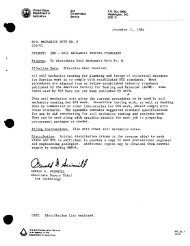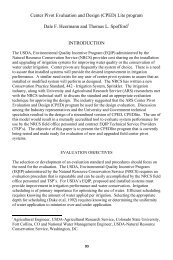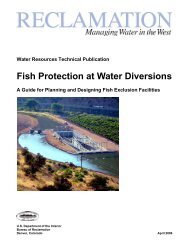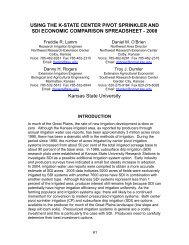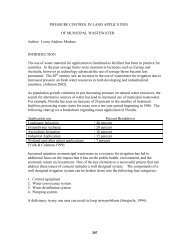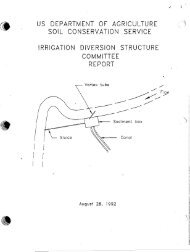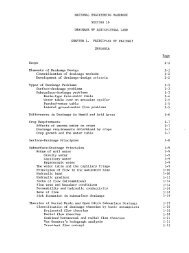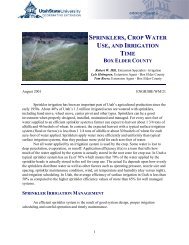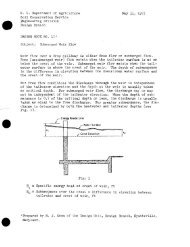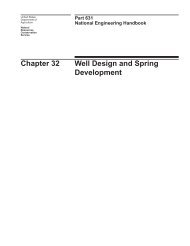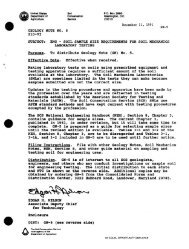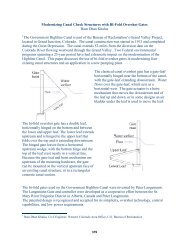Chapter 11: Sprinkle Irrigation - NRCS Irrigation ToolBox Home Page
Chapter 11: Sprinkle Irrigation - NRCS Irrigation ToolBox Home Page
Chapter 11: Sprinkle Irrigation - NRCS Irrigation ToolBox Home Page
Create successful ePaper yourself
Turn your PDF publications into a flip-book with our unique Google optimized e-Paper software.
Table <strong>11</strong>-4,-Suggested maximum application rates for<br />
sprinklers for average soil, slope, and tilth<br />
0-5% 5-8% 8-12% 12-16%<br />
Soil texture Slope Slope Slope Slope<br />
and profile<br />
(inlhr) (inlhr) (inlhr) (inlhr)<br />
1. Coarse sandy soil<br />
to 6 ft 2.0 1.5 1.0 0.50<br />
2. Coarse sandy soils<br />
over more compact<br />
soils 1.5 1.0 0.75 0.40<br />
3. Light sandy loam<br />
to 6 ft 1.0 0.80 0.60 0.40<br />
4. Light sandy loams<br />
over more compact<br />
soils 0.75 0.50 0.40 0.30<br />
5. Silt laams to 6 ft 0.50 0.40 0.30 0.20<br />
6. Silt loams over<br />
more compact<br />
soils 0.30 0.25 0.15 0.10<br />
7. Heavy-textured<br />
clays or clay<br />
loams 0 0.10 0.08 0.06<br />
Continuous-Move Systems<br />
Traveling sprinklers, Like periodic-move systems,<br />
are usually managed to apply relatively deep irrigations.<br />
Furthermore, drop sizes tend to be large so<br />
values from Table <strong>11</strong>-4 should be reduced by 25<br />
percent for use as guides to selecting maximum<br />
application rates for traveling sprinklers.<br />
It is practical to apply frequent, light applica*<br />
tions with center-pivot and linear-move systems.<br />
With light applications, up to 0.5 in of the applied<br />
water can be stored in small depressions on the soil<br />
surface. Because of this, the peak application rates<br />
near the end of center-pivot or linear-move laterals<br />
operating on a 1- or 2-day cycle can often be more<br />
than 100 percent greater than specified in Table<br />
<strong>11</strong>-4 and not cause runoff on slopes of less than 8<br />
percent. This is fortunate because it is difficult to<br />
nozzle centerpivot systems that have a maximum<br />
application rate of much less than 1.0 iph.<br />
<strong>Sprinkle</strong> <strong>Irrigation</strong> Efficiency<br />
<strong>Irrigation</strong> efficiency is a concept that is used extensively<br />
in system design and management, It can<br />
be divided into two components, uniformity of<br />
application and losses. If either uniformity is poor<br />
or losses are large, efficiency will be low. Several<br />
factors affect the water-application efficiency of<br />
sprinkle irrigation systems:<br />
1. Variation of individual sprinkler discharge<br />
along lateral lines can be held to a minimum by<br />
proper lateral design.<br />
2. Variation in moisture distribution within the<br />
sprinkler-spacing area is caused primarily by wind<br />
movement. For periodic move, fixed, and traveling<br />
sprinklers this can be partially overcome by closely<br />
spacing sprinklers or tow paths to meet adverse<br />
wind conditions. In addition to the variation caused<br />
by wind, there is always a variability in the distribution<br />
pattern of individual sprinklers. The extent<br />
of this variability depends on sprinkler design, operating<br />
pressure, and sprinkler rotation. For centerpivot<br />
and linear-move systems wind distortion is<br />
not a serious problem because the sprinklers are<br />
spaced close together along the lateral, and the lab<br />
eral is continuously moving.<br />
3. Loss of water by direct evaporation from the<br />
spray increases as temperature and wind velocities<br />
increase and as drop size and application rate decrease.<br />
4. Evaporation from the soil surface before the<br />
water reaches the plants decreases proportionally as<br />
greater depths of water are applied.<br />
Uniformity<br />
Distribution uniformity (DU) is a useful term for<br />
placing a numerical value on the uniformity of<br />
application. The DU indicates the uniformity of infiltration<br />
throughout the field.<br />
DU =<br />
Average low-quarter depth<br />
of water received<br />
Average depth of water received<br />
X 100<br />
The average low-quarter depth of water received is<br />
the average of the lowest one-quarter of the measured<br />
values where each value represents an equal<br />
area.<br />
Another parameter that is used continuously to<br />
evaluate sprinkle irrigation uniformity is the uniformity<br />
coefficient developed by Christiansen :<br />
where<br />
X * absolute deviation of the individual<br />
observations from the mean (in)<br />
' Chn'stianserr, J. E. 1942. <strong>Irrigation</strong> by sprinkling. University<br />
of California. Bull. No. 670.



